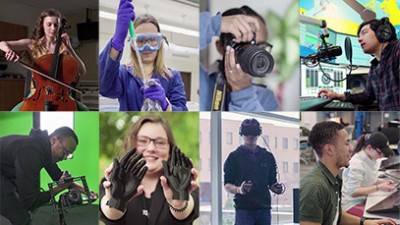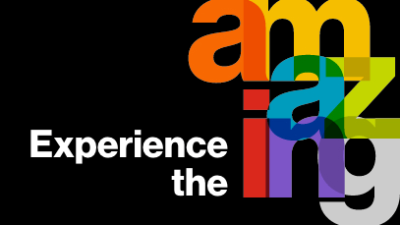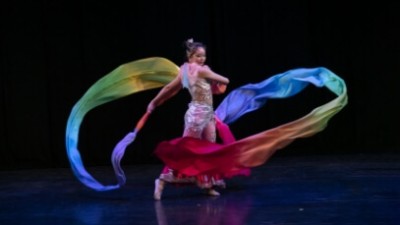RIT Breaks Ground on World-Class Field House and Activities Center
Facility will be second largest in county, next to Blue Cross Arena War Memorial
After years of dreaming and discussion, plans for a campus Field House and Activities Center have come to fruition.
The Lucius R. and Marie Gordon Field House and Activities Center celebrated its ground breaking, Sept. 25, with a ceremony honoring the Gordons, long-time contributors to RIT.
Designed foremost for student use, the field house will enhance campus spirit and provide the RIT community with a first-class, multi-purpose building that will complement other facilities on campus.
RIT President Albert Simone predicts that once constructed, it will be the most-used building on campus. "I believe this campus is incomplete without a field house," says Simone. "I’ve felt that since the first day I came here."
Expected to open by the summer of 2004, the $25 million, two-story building will be a signature structure on the RIT campus. Ideally situated in the heart of the campus, it will be the linking piece to a complex that includes the Hale-Andrews Student Life Center, Student Alumni Union, Ingle Auditorium, Clark Gymnasium and the Ritter Ice Arena.
The multi-purpose facility will provide an appropriate and permanent venue for major campus traditions and events. Among these are Commencement and Academic Convocation, Brick City Festival (student, parent, alumni weekend), concerts, guest lecturers and athletic events. The facility will be the second largest in the county, next to the Blue Cross Arena War Memorial.
"The Field House and Activities Center will be the crowning piece to an already impressive group of buildings," says Frank Lamas, associate vice president for student affairs. "It will give us the flexibility of doing things we’ve never been able to do before. It increases our possibilities."
Lamas, who began proposing a field house more than five years ago, says the high demand on existing facilities makes scheduling a constant challenge.
The Clark Gymnasium, constructed in 1968, can seat about 2,000. However, using Clark for special events such as guest speakers, concerts or community events means the gym is out of use for athletic practices and competitions and intramural sports for days at a time. The Hale-Andrews Student Life Center, which opened in 1992, provides space for basketball, jogging, racquetball, and other fitness activities but was not designed for large gatherings or events.
Like Clark Gymnasium, the swimming pool was built when RIT moved to the current campus in the late 1960s, with a population of about 10,000 students. Today, RIT has more than 15,000 students. Some 7,000 participate in intramural sports. Since 1992, participation in intercollegiate sports has increased 46 percent with athletics exceeding any other extracurricular activity.
Student expectations and interests have changed markedly over the years, adds Lamas. "When prospective students look at universities, of course their first consideration is the academics," he says. "But they also are interested in activities and amenities available on campus."
"A facility that allows the campus community to come together to play and learn and celebrate is critical to RIT’s success," says Simone.
The 155,000-square-foot facility will have the flexibility to host a variety of events and accommodate more than 8,000 people. It includes:
- A 60,000-square-foot event venue/athletic field, which can be divided into three sections, will hold more than 8,000 people for special events such as convocation, guest speakers, and concerts, and also accommodate activities such as lacrosse, tennis, floor/field hockey, indoor track, baseball, softball, soccer and volleyball. The plan includes a spacious lobby and mezzanine level with viewing to the field.
- A 27,000-square-foot aquatics center includes a competition pool, recreational pool, and spectator seating for about 150. The eight-lane, 25-meter competition pool features a moveable bulkhead to provide separation between the diving and swimming areas. The recreational pool includes a spa area with hot tub, waterspouts and a current channel for relaxation and therapy.
- A fitness center of approximately 16,000 square feet with areas for free-weights training and cardiovascular equipment.
Profile: Lucius R. (Bob) Gordon
RIT honored long-time friend and trustee Lucius R. Gordon, and his wife, Marie (Tony), on Sept. 25 by naming the new RIT Field House and Activities Center after them.
Gordon’s devotion to RIT is evident in both his service as a member of the Board of Trustees and his generosity over the years to many RIT projects. His gift to the Student Life Center funded the Marie and Lucius R. Gordon administrative wing; the crew team’s "Bob Gordon Shell" is due to his generosity; and the Lucius Gordon Drive of the Business Tech Park on Bailey Road recognizes his longstanding advocacy of the development of RIT’s land assets.
As an RIT trustee since 1975, he has served as a member of the Executive, Finance, Buildings and Grounds and Endowment committees and now holds the office of honorary vice chairman. He and his wife are members of the Nathaniel Rochester Society and have served on the Nominating and Executive committees. With his brother, Fred, he received the NRS Award in 1989. In 1997, he became a charter member of the Ellingson Society. On Sept. 1, 1999, RIT conferred an honorary doctorate of humane letters in recognition of his professional success and contributions to RIT.
Born in Brockport, N.Y., in 1912, he is the son of Fred Hooker Gordon Sr., who was a member of a pioneer Brockport family and president of Yates Coal Co. for about 40 years.
In addition to his honorary doctorate from RIT, Gordon holds a bachelor’s degree in industrial engineering from Yale/Sheffield Scientific School.
He has held many offices in business and organizations in Rochester and around the world including trustee of Allendale Columbia School, member of the Genesee Hospital Governor’s Advisory Board, honorary member of the Genesee Valley Club, advisory trustee to Hillside Children’s Center, and past director of Lightnin Mixers in Australia and England, Rochester Community Savings Bank, Rochester Telephone Corp., Stecher-Traung-Schmidt Corp. and United Community Fund.
Gordon is retired from Mixing Equipment Co. (MIXCO), a unit of General Signal Corp., as chairman of the board.
Comments from Bob Gordon:
"Al’s vision of the future—where RIT should fit in this world of evolving technologies—is the reason RIT is such an important university today.
"It has been a great experience to have been a small part in this exciting venture. I want you to know that from the day of Al’s inauguration, we often talked of the necessity of having a field house to complete the campus.
"Having experienced the important part a field house played in my years at Andover and Yale, I became one of Al’s most enthusiastic supporters for one at RIT. "It has been a great experience for me to see this idea grow from a vision to reality. I join all of you in your satisfaction in seeing ground being broken for this great dream.
"Perhaps Tony and I are the symbol of the many people who have helped make this field house possible, and for their support both large and small, but always generous."













